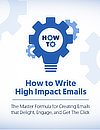The Ultra-Curious Way to Write an Attention Getting Headline
with 100% Confidence

Let’s face it … people can be fickle, especially when it comes to the stuff they read or see on the Internet.
In fact a report in Fast Company found that …
- The average web visitor reads only 6 words of a headline.
- The average time spent reading a blog article is 15 seconds.
- If a reader sticks around past 15 seconds, they’ll likely stay for 7 minutes.
When you think about it, 6 words is not nearly long enough for someone to fully process information. It’s more like they’re glancing at what you’ve written than actually reading it.
While it might seem like a daunting task to get their attention, the good news is there’s a way to do it that will have people not only stopping to see what you’ve written but wanting to know more.
And it all starts by writing an eye-catching headline. Luckily AWAI has developed a proven formula for writing headlines — the 4 U’s:
Useful: how does the headline help the reader?
Urgent: how does the headline move the reader to act?
Unique: how does the headline surprise the reader?
Ultra-specific: how does the headline give details to the reader?
A headline that embodies all 4 U’s is as close to writing a home-run headline as you can possibly do.
But there’s something else you can do to make your headline stand out … and that’s by making it ultra-curious.
Curiosity may have killed the cat, as the saying goes, but for humans it’s part of our nature. In fact, psychologists Jordan Litman and Paul say there are two types of curiosity: I-Curiosity and D-Curiosity.
I-Curiosity is interest-driven and kicks in when we become interested in learning more about something. For example, did you know that there are animals who keep growing in size until they die? They are called indeterminate growers, and include sharks, lobsters, and even kangaroos.
D-Curiosity is a lack of information, meaning we’re looking for or need to know specific information. For example, you’re in a meeting and your cell phone vibrates. It’s hard to concentrate on the meeting when what you really want to do is see who called you.
Both of these forms of curiosity can be used to create headlines. In copywriting, we call it the curiosity gap. It’s the space between what we know and what we want to know and forces the prospect to fill in the gap.
And using it in headlines works. The folks at Copyhackers did a test to prove just how much curiosity works.
They ran two sets of creative. The body copy was the same while the headlines varied. One headline was straightforward and direct in approach. The other one was more curiosity-driven.
The result of their test? The curiosity headline outperformed the direct approach by 927%. That’s a big difference in results.
Headlines are so important to Upworthy, that before an article is posted to their website, writers come up with 25 different ones. Then they narrow it down to just a few finalists. From there, they pick the winner using certain criteria.
One of the key criteria used is if the headline arouses a high degree of curiosity. Here are a few examples of the kind of headlines they write:
- They thought they were going to hang with friends but ended up attending their own funeral
- A wild goose was taken to an animal hospital. His mate knocked on the door to find him.
- How one of the ocean’s worst and smallest swimmers managed to adventure across the world
So how do you put curiosity in the headlines you write for clients? There are a couple of ways to go about including:
Curiosity Way #1: Introduce something new that your target audience doesn’t know about or has little previous experience with
Curiosity Way #2: Start a story but don’t fill in all the details, which makes the reader want to uncover more information.
Curiosity Way #3: Withhold key information that forces the reader to want to know what’s missing.
Curiosity Way #4: Introduce a new idea, action, or concept … and connect it with an unexpected outcome or subject.
Curiosity Way #5: Make a listicle but be sure the items you’re talking about seem not ordinary.
These are just a few ways to get you started writing headlines that ring with curiosity. Once you start practicing these techniques, they’ll become second nature. And you’ll be able to write a headline filled with curiosity in no time at all.
Doing this exercise is good for all types of writing projects you’ll do whether it’s writing a compelling blog post, newsletter article, or a series of emails for your client.

How to Write High Impact Emails
Learn how to write winning emails from one of the best email writers in the industry today. From writing subject lines that get noticed to “call to actions” that get results, it’s all included in this home study program. Learn More »
Guest, Add a Comment
Please Note: Your comments will be seen by all visitors.